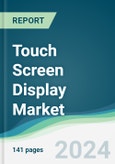The touchscreen display market is expected to grow at a CAGR of 8.79% reaching a market size of US$101.751 billion in 2029 from US$56.435 billion in 2022.
The touchscreen display market has experienced significant growth in recent years, driven by the increasing demand for user-friendly and interactive devices across various industries. Touchscreen displays offer a seamless user interface and have become essential in modern electronic devices, including smartphones, tablets, laptops, and gaming consoles. The touch screen displays market is expected to continue its growth trajectory, driven by advancements in touch screen technologies such as capacitive, resistive, and surface acoustic wave (SAW) displays. Additionally, the emergence of new technologies such as flexible touch screens, transparent displays, and haptic feedback displays are expected to further fuel the growth of this market.The market growth is further fueled by technological advancements in touch-based gesture recognition, which supports various gestures including pinch-to-zoom, swipe (or flick), twist, press-and-hold (or long press), and slide. The need for capacitive touch screen controllers is being driven by the rise in touch screen shipments as well as the replacement of resistive technology in automotive applications by projected capacitive touch screens.
Increasing demand for smartphones and tablets
The global smartphone market has witnessed significant growth in recent years, fueled by the increasing demand for mobile devices that offer advanced features and functionalities. Touchscreen displays have become an essential component of smartphones and tablets, providing a seamless user interface enabling users to interact more intuitively. In addition, the increasing availability of low-cost smartphones and the rising adoption of mobile devices in emerging economies are expected further to fuel the growth of the touchscreen display market.Rising demand for interactive displays
Interactive touchscreen displays are increasingly used in the retail and hospitality industries to provide a more engaging and personalized customer experience. Interactive displays are used for various applications such as product demonstrations, ordering systems, and wayfinding. With the growing trend towards experiential retail, touchscreen displays are becoming an essential component of retail environments, providing retailers with a means to differentiate themselves and offer a unique customer experience.High demand for predictive touch technology
The patented "predictive touch" technology was developed by University of Cambridge engineers in collaboration with Jaguar Land Rover. This technology speeds up the pointing process by using machine intelligence to predict the object on the screen that the user intends to select early on. Furthermore, it makes use of a gesture tracker, which incorporates vision- or RF-based sensors - both of which are seeing an increase in popularity in consumer electronics. It might also be utilized for projections 3D or 2D holograms, or other displays without a physical surface. It also offers greater design flexibility by promoting inclusive design principles and enabling seamless customization of interface functionality for specific users.Advancements in Projected Capacitive Touch Technology
In smartphones, smart TVs, and other consumer electronics, projected capacitive touch technology enables users to pinch, scroll, zoom, and lightly tap. Custom-designed projected capacitive touch screens are swiftly overtaking other options as the preferred high-tech product. Additionally, most touch screens now use the concept of projected capacitance to detect a touch rather than the earlier methods of detecting a difference in electrical resistance or the breakdown of light beams. This generally refers to the capacity of a touch screen to store an electric charge, which is then changed or released in response to the approach of a finger, conductive stylus, or other object. Furthermore, unlike resistive touch screens, capacitive touch screens operate without the need for finger pressure.North America is witnessing exponential growth during the forecast period
The North American touchscreen display market is expected to grow substantially during the projected period, driven by various factors. One key factor is the increasing adoption of touchscreen displays in retail, healthcare, and other sectors, which enhance customer experience and increase operational efficiency. Additionally, advancements in touchscreen technology, such as haptic feedback and pressure sensing, are also driving growth in the market as they enable more immersive and intuitive user experiences. Another important factor is the growing demand for touchscreen displays in the automotive industry, which are used for infotainment systems and other applications.Market key launches
- In January 2023, full-scale mass production of the first large-sized OCTA (On-Cell Touch AMOLED) panel will begin, as announced by Samsung Display today. This development expands the technology's application beyond OLED smartphones to laptops.
- In July 2023, a leading international supplier of visual solutions, ViewSonic, announced on Wednesday the arrival in the nation of its first portable touchscreen monitor featuring OLED technology, the VP-16 OLED. With its 1080p Full HD resolution and Pantone Validation, the 15.6-inch ColorPro monitor offers excellent colour reproduction and captivating visuals. It has an OLED display, which reproduces blacks flawlessly and provides clear, halo-free images.
Segmentation:
By Screen Type
- Capacitive Touch Screens
- Resistive Touch Screens
- Surface Acoustic Wave Type Displays
- Infrared Touch Screens
- Others
By Application
- Laptop
- Smartphone
- Smart TV
- Others
By Geography
- North America
- USA
- Canada
- Mexico
- South America
- Brazil
- Argentina
- Others
- Europe
- Germany
- France
- UK
- Spain
- Others
- Middle East and Africa
- Saudi Arabia
- UAE
- Others
- Asia Pacific
- China
- Japan
- India
- South Korea
- Taiwan
- Others
Table of Contents
Companies Mentioned
- Panasonic Corporation of North America
- SAMSUNG
- Mouser Electronics, Inc.
- DISPLAX
- Fujitsu
- LG Electronics
- BOE Technology UK Limited.
- NEC Corporation
- AUO Display Plus Corp
Table Information
| Report Attribute | Details |
|---|---|
| No. of Pages | 141 |
| Published | February 2024 |
| Forecast Period | 2022 - 2029 |
| Estimated Market Value ( USD | $ 56.44 Billion |
| Forecasted Market Value ( USD | $ 101.75 Billion |
| Compound Annual Growth Rate | 8.7% |
| Regions Covered | Global |
| No. of Companies Mentioned | 9 |









